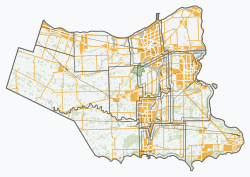Niagara Region | |
|---|---|
| Regional Municipality of Niagara | |
| Motto: Unity, Responsibility, Loyalty | |
 Location of Niagara within Ontario | |
| Coordinates: 43°02′33″N79°18′02″W / 43.04250°N 79.30056°W [1] | |
| Country | Canada |
| Province | Ontario |
| Formed | 1970 (from Welland and Lincoln Counties) |
| Seat | Thorold |
| Government | |
| • Chair | Jim Bradley |
| • Governing body | Niagara Regional Council |
| • MPs | Dean Allison, Chris Bittle, Fred Davies, Tony Baldinelli |
| • MPPs | Jeff Burch, Wayne Gates, Sam Oosterhoff, Jennie Stevens |
| Area | |
| • Land | 1,852.82 km2 (715.38 sq mi) |
| Population (2021) [2] | |
• Total | 477,941 |
| • Density | 258/km2 (670/sq mi) |
| Gross Metropolitan Product | |
| • St. Catharines – Niagara CMA | CA$17.4 billion (2020) [3] |
| Time zone | UTC−05:00 (EST) |
| • Summer (DST) | UTC−04:00 (EDT) |
| Website | www |
The Regional Municipality of Niagara, also colloquially known as the Niagara Region or Region of Niagara, is a regional municipality in southern Ontario, Canada, which occupies most of the Niagara Peninsula. As of 2024, the region had an estimated population of 539,180. [4] St. Catharines is the region's largest city, while the regional seat is located in Thorold.
Contents
- Administrative divisions
- Demographics
- Religion
- Ethnicity
- Human trafficking
- Transportation
- Airports
- Public Transport
- Highways
- Education
- Notable people
- See also
- Notes
- References
- External links
The Niagara Region is bounded to the north by Lake Ontario and to the south by Lake Erie. The region is bordered in the west by Haldimand County and the City of Hamilton, with its eastern boundary at the Niagara River, which is also the international border with the US state of New York. The Niagara Region is the southernmost part of the Golden Horseshoe, the most populated region of Ontario.
Unique natural landscapes make the Niagara Region an important centre for agriculture and tourism in Canada. The most important agricultural enterprise in Niagara is viticulture, or winemaking. The Niagara Wine Route, which connects visitors to dozens of wineries, is a growing tourism draw while the internationally renowned Niagara Falls is one of Canada's major tourist attractions. Along with Shaw Festival, held annually in Niagara-on-the-Lake, and the Welland Canal, the Regional Municipality of Niagara receives up to 12 million visitors each year. The Niagara Region has been populated by First Nations such as the Neutral, the Haudenosaunee, and the Anishinaabe, including the Mississaugas of the Credit First Nation. [5]






